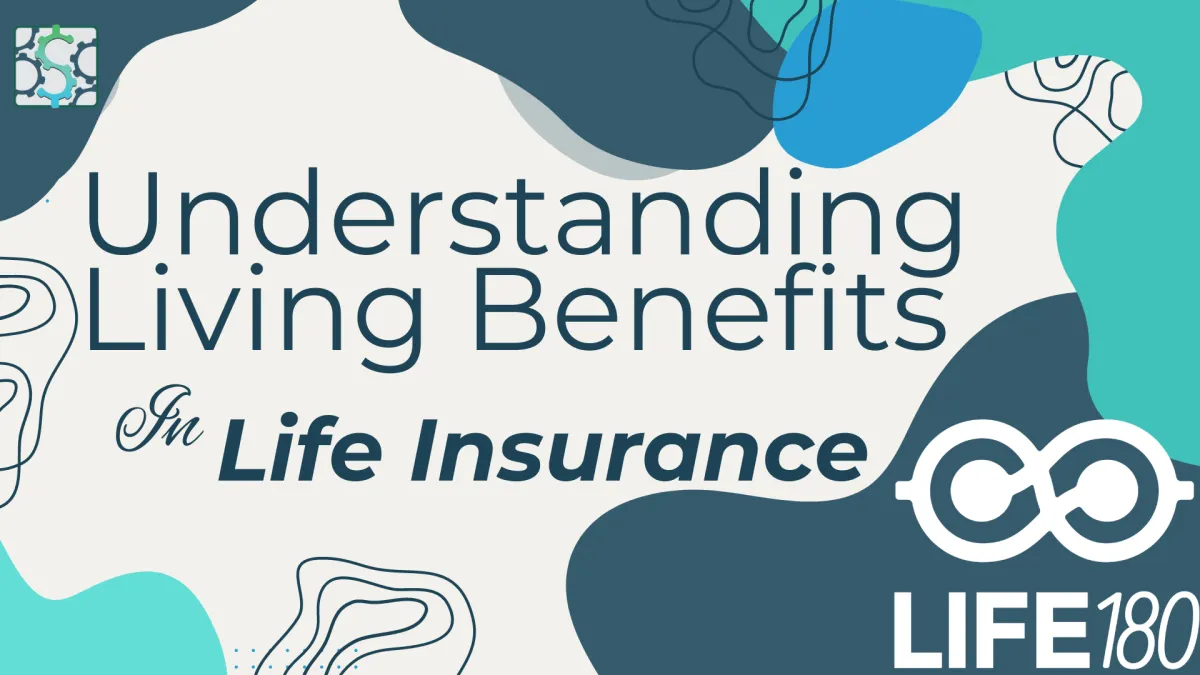
Simplifying Financial Confusion
LEARN CASH FLOW HACKING TO REACH FINANCIAL FREEDOM
Used by 90% of millionaires to reach their financial goals 4x faster

Achieve Financial Freedom Through Cash Flow Hacking

Increase Your Lifestyle While You Build Your Wealth

Position Yourself to Thrive in Market Downturn
YOU SHOULD NOT FEEL OUT OF CONTROL ABOUT YOUR FINANCIAL STRATEGY

Have easy access to your money in case of emergencies and opportunities

Use the investment strategy 90% of millionaires use

You deserve a clear plan to consistently grow your money and avoid market uncertainty

Have a guide and advisor that has your best interest in mind

Do not overpay in taxes

Stop guessing at the best vehicles to protect and grow your money

How Living Benefits Work With Life Insurance
This article is a written adaptation of the video you can find on our YouTube channel, LIFE180.
Today, we’re discussing the concept of living benefits with life insurance. Life insurance often gets a bad reputation for being seen merely as "death insurance." After all, why would it be called life insurance if the only way to access the funds is after death?
If you think of life insurance solely as death insurance, it might seem like it’s not about the benefits you receive, but rather what your family gains after you’re gone. In that sense, whether or not you get to use it during your lifetime might seem irrelevant.
When you think about it, life insurance is a decision rooted in love and care for your family. It’s about asking yourself, "If something tragic were to happen to me, if I were to pass away unexpectedly, how would my loved ones manage? Would my spouse, children, and family be able to achieve the goals I would have helped them reach had I lived a long, fulfilling, and productive life?"
For some, that isn’t a concern; there are people who, unfortunately, don’t care about what happens to their loved ones after they’re gone. I find that to be a sad perspective. But beyond that, it's crucial to realize that life insurance can offer more than just a death benefit. There are living benefits that can be an integral part of your life insurance policy.
To put it simply, let’s define what living benefits are. In essence, living benefits refer to your ability to access certain benefits within your life insurance policy while you’re still alive. That’s all it means, having the option to utilize parts of your policy before passing away.
These living benefits can take various forms, depending on the type of policy you have. For instance, they might include access to the cash value if your policy has a cash value component. Other benefits could be available if you face specific situations, such as becoming critically ill, chronically ill, or terminally ill. Some policies even offer long-term care riders. As mentioned earlier, accessing the cash value is one option among several that can provide valuable support while you’re still alive.
Different Ways To Use Whole Life Insurance WHILE YOU ARE ALIVE
There are numerous ways to access the benefits in your policy while you're still alive, allowing you to address various needs. I often share a personal story to illustrate this. My father-in-law was diagnosed with stage 4 pancreatic cancer on November 4th, 2020, and was given just 90 days to live.
Thankfully, he was able to accelerate the death benefit and access the living benefits due to his terminal diagnosis. Despite the grim prognosis from traditional oncologists, we were able to use a significant amount of money from the accelerated benefits to fund alternative treatments that followed more natural and holistic approaches.
While many people consider “traditional medicine” to be Western medicine, I think of traditional medicine as the methods used before modern technology existed, focusing on the body's inherent ability to heal itself. My father-in-law is living proof of this.
As of today, August 17th, 2024, we are approaching four years since my father-in-law’s initial diagnosis. This is the same man who was diagnosed with stage 4 pancreatic cancer, facing a seven-and-a-half-centimeter tumor that had spread from his pancreas to his liver.
Because we were able to accelerate the death benefit and access tax-free funds, we could pursue various treatments, essentially anything we felt was in his best interest at the time. This flexibility allowed us to find doctors and treatments that gave him a fighting chance.
Today, my father-in-law is still playing golf four days a week and enjoying life, spending valuable time with his family and grandchildren. In fact, my wife is in Arizona visiting them right now, while I'm here in the Dominican Republic. These experiences highlight aspects of life insurance that many people may not realize, specifically, the potential to use living benefits.
It's important to note that not every life insurance policy offers these benefits, and the availability of living benefits can vary depending on the type of insurance, whether it’s term life, whole life, indexed universal life, traditional universal life, or variable universal life. Each type of policy has different features and options.
For instance, let’s focus on whole life insurance. You could purchase a whole life policy, but it's important to understand that different companies offer different living benefits. The range and specifics of these benefits can vary significantly from one insurer to another.
That’s why I always emphasize the importance of choosing the right policy design and the right insurance company for your needs. It’s not just about picking any policy; it’s about finding one that aligns with your values and beliefs.
You need to consider what specific problems you’re trying to solve and what concerns you have now and for the future. It's essential to evaluate all these different variables to make an informed decision.
Not Every Company Provides The Same Living Benefits With Life Insurance
This is why we partner with the companies we do: each one addresses different needs and problems. For example, while companies like MassMutual and Guardian offer strong cash value growth and stability, their living benefits might not be as robust.
On the other hand, there are other companies that provide excellent stability, historical performance, growth potential, and liquidity. These factors are crucial when considering banking policies, cash flow strategies, and infinite banking structures, which are all integral to our approach.
When weighing these options, what often stands out is the added value of having a company that not only performs well but also offers strong living benefits. If you can find a company that provides both solid performance and additional living benefits, it can offer significant advantages. It’s worth considering this balance when making your decision, as some companies might excel in certain areas but lack in others.
This distinction becomes particularly important with term insurance. While many term insurance policies are inexpensive, there are options available that include living benefits even while you’re alive. This added feature can provide additional value beyond the basic coverage.
For example, if you’re 40 years old and purchase a 20-year term policy, you might opt for the most basic and affordable option. The cost is likely to be lower because the probability of dying before you turn 60 is relatively low.
However, the likelihood of needing access to living benefits, such as for chronic or terminal illness, is significantly higher. Therefore, while the cost of a policy with living benefits may be somewhat higher, the potential value and support it offers can be much greater. Understanding this trade-off is crucial when evaluating the various living benefits options available.
Different Accelerated Benefit Rider on Life Insurance Policies
With that background in mind, let’s delve into the different types of accelerated benefit riders available on policies. Essentially, these riders allow you to accelerate the death benefit. This means that rather than waiting until the end of the policy term, you can access a portion of the death benefit early, under certain conditions.
Typically, the most common and straightforward accelerated benefit rider comes into play if you're diagnosed with a terminal illness. For example, if you’re diagnosed with cancer or a similar condition and given between 12 and 24 months to live, this usually qualifies you for the terminal illness rider on your policy. This rider allows you to access a portion of the death benefit while you’re still alive, and the funds are provided to you on a tax-free basis.
You can use the accelerated benefit funds for any purpose you choose, whether it's for medical treatment, taking a vacation to enjoy time with your family, or other personal needs. I've even had clients who received the death benefit while still alive and chose to gift it to their family. This allows them to experience the joy of passing on financial support while they are still here.
Another type of accelerated benefit rider is the chronic illness rider. This rider allows you to access benefits if you’re unable to perform certain daily living activities. Generally, although not universally applicable, you may qualify for the chronic illness rider if you’re unable to perform at least two out of six essential activities of daily living, such as bathing or dressing, or if you experience cognitive impairments like Alzheimer's or dementia.
However, it's important to note that not every insurance company offers the chronic illness rider. If this is a concern for you, make sure to select a company that includes this benefit in their policies.
The third type is the critical illness rider. This rider, which is less common and not available with every insurer, allows you to access a portion of your death benefit if you’re diagnosed with a serious condition, such as a less severe type of cancer, a heart attack, or a stroke. It provides financial support during these critical moments.
When reviewing your policy, carefully examine the illustrations provided to you. Check if the critical illness rider is included and assess its details. Similarly, review the chronic illness rider to ensure it meets your needs. It’s essential to confirm that these riders allow you to accelerate the death benefit if you experience one of these qualifying events.
How To Use Accelerated Benefit Riders on Life Insurance Policies
A common question is how to actually use these riders if they’re included in your policy. The process is similar to filing a claim for a death benefit. You’ll need to provide medical documentation, which includes obtaining statements from your doctor to confirm your medical condition.
Then, you’ll file a claim with the life insurance company. Just as with a death benefit claim, where a death certificate is required, there’s a process to follow. However, it’s generally a straightforward procedure: gather the necessary information and documentation, submit your claim, and the insurance company will handle the acceleration of benefits according to the terms of your contract.
The amount of money available through these riders will vary depending on the specifics of your contract. Generally, the portion of the death benefit that you can accelerate depends on the type of insurance you have and the design of your policy. Each policy may have different terms regarding how much of the death benefit can be accessed under these riders.
After utilizing these benefits, it’s important to consider how much death benefit will remain on the back end of your policy. Assessing this impact will help you understand what’s left for your beneficiaries. You can receive accelerated benefits, whether for critical, chronic, or terminal illness, in various payment options. You might choose to get paid in a lump sum, monthly installments, or semi-annually.
This flexibility allows you to structure the payments in a way that best suits your needs. Much like choosing between a lump sum or annuity payment when winning the lottery, opting for smaller, periodic payments may provide a greater overall benefit.
When evaluating the impact of accelerated death benefit riders, it's important to consider both the positives and the drawbacks. One of the main drawbacks is that accessing these benefits while you're alive will reduce the amount of death benefit available to your beneficiaries. This reduction is a key factor to weigh when deciding whether to use these riders.
How To Use Accelerated Benefit Riders on Life Insurance Policies
My advice is that if living benefits are important to you, ensure you have sufficient life insurance coverage to support these needs. This way, you can take advantage of the living benefits while still maintaining an adequate death benefit for your beneficiaries. It’s essential to balance the coverage so that you can access the benefits you need while preserving enough death benefit for the future.
The benefits of having these riders are quite clear and straightforward. They provide you with greater control over your medical care and decisions, ensuring that you have a say in your treatment. Additionally, they help maintain your dignity in medical situations, allowing you to manage your health and care with respect and autonomy.
For example, if you require assisted living or in-home care due to medical issues, these riders can provide financial support as long as you meet the qualifying conditions. However, it’s crucial to ensure that accessing these funds doesn’t significantly reduce your death benefit, which could impact the legacy you intend to leave behind.
A significant advantage of these benefits is that they are typically included in the basic premium of your policy, rather than being added as separate riders at additional costs. Essentially, these benefits are integrated into the premium you pay. However, as with anything, there’s no such thing as a free lunch. For instance, if the basic term policy costs $100 per month without living benefits, a policy with living benefits might cost around $130 to $140 per month.
You need to ask yourself whether the extra cost of $30 to $40 per month is worth it for the ability to access benefits while you’re alive. This decision will depend on your health rating and the underwriting process with the insurance company.
For me, the answer is a definite yes. I’m fully prepared to pay a bit more because, when you compare the cost of medical insurance or health insurance with the cost of including these benefits in your life insurance policy, it’s a more efficient way to address similar risks.
I’m not suggesting that life insurance with living benefits replaces health insurance, but it can be a valuable supplement. Many people have high-deductible catastrophic health insurance policies, paying around $400 a month with a $10,000 deductible, just to be covered in case of a serious illness like cancer.
In contrast, with a life insurance policy that includes living benefits, if you're diagnosed with terminal cancer, you can access the death benefit. This can be a much more cost-effective solution compared to paying high premiums and deductibles for health insurance.
How To Use Accelerated Benefit Riders on Life Insurance Policies
In conclusion, I’m a strong advocate for living benefits. They have profoundly impacted my family's life, my father-in-law is still with us today because of them. Before my own experience in 2020, I didn’t emphasize these benefits as much, but now they are a central topic in my content. I believe they are a crucial component of life insurance policies, and their importance often becomes clear only when you are personally affected by them.
A crucial question in finance is always, "Compared to what?" When you compare the cost of living benefits to alternative options in the market, they are often just pennies on the dollar. The value they provide relative to their cost is significant, making them a highly cost-effective choice.
If you’re considering purchasing life insurance to protect your family and your own future, I strongly encourage you to explore your options in more detail. You can set up a clarity call with a member of the LIFE180 team to gain a better understanding of how life insurance can work for you. Click the link below to schedule your call and get the clarity you need.
I hope you found this video valuable in understanding how living benefits work. If you did, please share it with others who might benefit from this information. If you have any questions or need further clarification, don’t hesitate to reach out.
Until next time, have a blessed and inspirational day.
HOW TO START TAKING CONTROL OF YOUR FINANCES BY MAXIMIZING YOUR CASH FLOW AND PROTECTING YOUR ASSETS

1. Schedule Your Free Clarity Call

2. Create a Free Customized Plan

3. Get Guide to Financial Success
GET YOUR FREE COPY TO STOP USING OUTDATED RETIREMENT STRATEGIES
Cash Flow Hacking teaches you to:
Protect Your Investments
Thrive in bad markets
Reach financial freedom faster

ARE YOU LOOKING FOR:

Cash Flow Hacking teaches you to:
Security to protect your money
Increased cash flow and lifestyle
Inflation protection
Financial certainty in all economic environments
A reduction in taxes
Safe and fast access to your money with no penalties
WHO IS THIS PROGRAM FOR?

People looking for an alternative
Are you looking for alternatives to Wall Street’s “buy and hold” strategy that takes 40 years with uncertain results? Our Cash Flow Hacking strategies provide you the building blocks to get started on the right foot

Passionate Entrepreneurs
Are you looking for a financial strategy that will take your best assets (you and your businesses) and multiply their potential? Our Cash Flow hacking strategies will teach you how to invest for the future without sacrificing building your business

Real Estate
Investors
Are you a real estate investor who is burned out from being a landlord or playing the fix-and-flip game? Our Cash Flow Hacking strategies will provide you with the system to create predictable wealth AND give you the freedom you are looking for.
YOU DESERVE PEACE OF MIND AND A PLAN THAT WILL PROTECT YOUR FAMILY AND GROW YOUR WEALTH
Today you need to be more savvy than ever if you try to go at it alone.
Losing money to inflation, taxes, and just poor investment strategies is leaving you frustrated, feeling out of control and not knowing where to turn. To add to the problem, the market is flooded with advisors who have outdated advice that does not place your best interests first, but instead focuses on charging you a fee that creates guaranteed cash flow for them.
NOT YOU
We believe this is wrong and that your security and best interests should be placed first. We believe you should be in a position where you control your money, your money doesn't control you. We understand because we talk with hardworking people everyday that are losing money in the markets based on old information and feel like they are guessing at the best course of action.
We created the Cash Flow Hacking plan to help you have security and control of your money to take advantage of life's opportunities because you deserve peace of mind with your wealth. The old way of planning for retirement of… Go to school Get a job & save as much as you can in your 401k and mutual funds...is broken.
You have been lied to. Think about it, where else in life does someone tell you that the most certain way to achieve your desired result is to take on more risk? The math just doesn't work, and the results are showing in our country and world. Did you know that 90% of millionaires in the United States have 1 asset in common?
Hint: it's not stocks or mutual funds (and no...it's not crypto) How much sense does it make for you to work hard, save money, reduce your current lifestyle (because that's what you are doing when you save for the future - taking money you could use on lifestyle today and delaying gratification to a future unknown time), and hope that whatever you are doing will work three to four decades from now? If you're thinking, "not much sense at all…", you are in the right place.
With over 50 years of experience on our team, we have worked with thousands of individuals and families to achieve financial freedom faster and with more predictability by helping them invest for Cash Flow.
How does the Cash Flow Hacking Plan work? 1. Take the Cash Flow Hacking Challenge 2. Complete the LIFE180 X-Ray and determine what your Freedom Number is 3. Work with a Cash Flow Hacking expert to provide you a customized plan
The customized Cash Flow Hacking plan will give you clarity on where you are now, where you want to go (and in what time frame), and what you need to do to get there predictably.
We value and commit to you: We believe you deserve the best financial education and guidance We believe financial decisions should not be rushed but be well thought out with a plan We believe you should be in control of your money We believe we earn your trust through time, education, and proper due diligence Without a proper plan and guidance, your money can be lost to taxes, inflation, and bad investments You deserve more with the most up-to-date strategies to mitigate your risk, control your money, and earn stable returns regardless of the market Schedule a call here to attain your LIFE180 Financial X-Ray now or get started with the Cash Flow Hacking Challenge for free.
I am interested in...